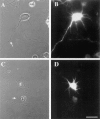Unique responses of differentiating neuronal growth cones to inhibitory cues presented by oligodendrocytes
- PMID: 9660873
- PMCID: PMC2133022
- DOI: 10.1083/jcb.142.1.191
Unique responses of differentiating neuronal growth cones to inhibitory cues presented by oligodendrocytes
Abstract
During central nervous system development, neurons differentiate distinct axonal and dendritic processes whose outgrowth is influenced by environmental cues. Given the known intrinsic differences between axons and dendrites and that little is known about the response of dendrites to inhibitory cues, we tested the hypothesis that outgrowth of differentiating axons and dendrites of hippocampal neurons is differentially influenced by inhibitory environmental cues. A sensitive growth cone behavior assay was used to assess responses of differentiating axonal and dendritic growth cones to oligodendrocytes and oligodendrocyte- derived, myelin-associated glycoprotein (MAG). We report that >90% of axonal growth cones collapsed after contact with oligodendrocytes. None of the encounters between differentiating, MAP-2 positive dendritic growth cones and oligodendrocytes resulted in growth cone collapse. The insensitivity of differentiating dendritic growth cones appears to be acquired since they develop from minor processes whose growth cones are inhibited (nearly 70% collapse) by contact with oligodendrocytes. Recombinant MAG(rMAG)-coated beads caused collapse of 72% of axonal growth cones but only 29% of differentiating dendritic growth cones. Unlike their response to contact with oligodendrocytes, few growth cones of minor processes were inhibited by rMAG-coated beads (20% collapsed). These results reveal the capability of differentiating growth cones of the same neuron to partition the complex molecular terrain they navigate by generating unique responses to particular inhibitory environmental cues.
Figures







Similar articles
-
Development of neuronal polarity: GAP-43 distinguishes axonal from dendritic growth cones.Nature. 1988 Dec 15;336(6200):672-4. doi: 10.1038/336672a0. Nature. 1988. PMID: 3059197
-
Retinal axon regeneration in the lizard Gallotia galloti in the presence of CNS myelin and oligodendrocytes.Glia. 1998 May;23(1):61-74. doi: 10.1002/(sici)1098-1136(199805)23:1<61::aid-glia6>3.0.co;2-7. Glia. 1998. PMID: 9562185
-
Myelin-associated glycoprotein inhibits neurite/axon growth and causes growth cone collapse.J Neurosci Res. 1996 Nov 15;46(4):404-14. doi: 10.1002/(SICI)1097-4547(19961115)46:4<404::AID-JNR2>3.0.CO;2-K. J Neurosci Res. 1996. PMID: 8950700
-
[Mechanisms of growth of neuronal axons and dendrites].Cesk Fysiol. 2013;62(2):47-53. Cesk Fysiol. 2013. PMID: 24392595 Review. Czech.
-
Organization of microtubules in axonal growth cones: a role for microtubule-associated protein MAP 1B.J Neurocytol. 1993 Sep;22(9):717-25. doi: 10.1007/BF01181317. J Neurocytol. 1993. PMID: 8270956 Review.
Cited by
-
Isolation and expression pattern of human Unc-33-like phosphoprotein 6/collapsin response mediator protein 5 (Ulip6/CRMP5): coexistence with Ulip2/CRMP2 in Sema3a- sensitive oligodendrocytes.J Neurosci. 2001 Sep 15;21(18):7203-14. doi: 10.1523/JNEUROSCI.21-18-07203.2001. J Neurosci. 2001. PMID: 11549731 Free PMC article.
-
Recombinant DNA vaccine against inhibition of neurite outgrowth promotes functional recovery associated with endogeous NGF expression in spinal cord hemisected adult rats.Neurochem Res. 2009 Sep;34(9):1635-41. doi: 10.1007/s11064-009-9951-6. Epub 2009 Apr 1. Neurochem Res. 2009. PMID: 19337830
-
The Extracellular Environment of the CNS: Influence on Plasticity, Sprouting, and Axonal Regeneration after Spinal Cord Injury.Neural Plast. 2018 Apr 18;2018:2952386. doi: 10.1155/2018/2952386. eCollection 2018. Neural Plast. 2018. PMID: 29849554 Free PMC article. Review.
-
TBI and sex: crucial role of progesterone protecting the brain in an omega-3 deficient condition.Exp Neurol. 2014 Mar;253:41-51. doi: 10.1016/j.expneurol.2013.12.004. Epub 2013 Dec 18. Exp Neurol. 2014. PMID: 24361060 Free PMC article.
-
Rho Inhibitor VX-210 in Acute Traumatic Subaxial Cervical Spinal Cord Injury: Design of the SPinal Cord Injury Rho INhibition InvestiGation (SPRING) Clinical Trial.J Neurotrauma. 2018 May 1;35(9):1049-1056. doi: 10.1089/neu.2017.5434. Epub 2018 Mar 1. J Neurotrauma. 2018. PMID: 29316845 Free PMC article. Clinical Trial.
References
-
- Angevine JB., Jr Time of neural origins in the hippocampal region. An autoradiographic study in the mouse. Expl Neurol Suppl. 1965;2:1–70. - PubMed
-
- Angevine, J.B., Jr. 1975. Development of the hippocampal region. In The Hippocampus Vol. 1: Structure and Development. R.L. Isaacson, K.H. Pribram, editors. Plenum Press, New York. 61–94.
-
- Autillo-Touati A, Chamak B, Araud D, Vuillet J, Seite R, Prochiantz A. Region-specific neuro-astroglial interactions: ultrastructural study of the in vitroexpression of neuronal polarity. J Neurosci Res. 1988;19:326–342. - PubMed
-
- Banker GA, Cowan WM. Rat hippocampal neurons in dispersed cell culture. Brain Res. 1977;126:397–425. - PubMed
Publication types
MeSH terms
Substances
Grants and funding
LinkOut - more resources
Full Text Sources
Research Materials

